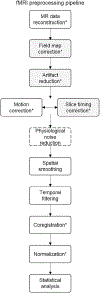Pain Neuroimaging in Humans: A Primer for Beginners and Non-Imagers
- PMID: 29608974
- PMCID: PMC6192705
- DOI: 10.1016/j.jpain.2018.03.011
Pain Neuroimaging in Humans: A Primer for Beginners and Non-Imagers
Abstract
Human pain neuroimaging has exploded in the past 2 decades. During this time, the broader neuroimaging community has continued to investigate and refine methods. Another key to progress is exchange with clinicians and pain scientists working with other model systems and approaches. These collaborative efforts require that non-imagers be able to evaluate and assess the evidence provided in these reports. Likewise, new trainees must design rigorous and reliable pain imaging experiments. In this article we provide a guideline for designing, reading, evaluating, analyzing, and reporting results of a pain neuroimaging experiment, with a focus on functional and structural magnetic resonance imaging. We focus in particular on considerations that are unique to neuroimaging studies of pain in humans, including study design and analysis, inferences that can be drawn from these studies, and the strengths and limitations of the approach.
Perspective: This article provides an overview of the concepts and considerations of structural and functional magnetic resonance neuroimaging studies. The primer is written for those who are not familiar with brain imaging. We review key concepts related to recruitment and study sample, experimental design, data analysis and data interpretation.
Keywords: Pain; functional connectivity; functional magnetic resonance imaging; guidelines; magnetic resonance imaging; multivoxel pattern analysis; structural magnetic resonance imaging.
Published by Elsevier Inc.
Conflict of interest statement
The authors have no conflicts of interest to declare.
Figures



Similar articles
-
Recent advances in objectifying pain using neuroimaging techniques.J Neurophysiol. 2018 Aug 1;120(2):387-390. doi: 10.1152/jn.00171.2018. Epub 2018 May 16. J Neurophysiol. 2018. PMID: 29766766 Free PMC article. Review.
-
What has functional connectivity and chemical neuroimaging in fibromyalgia taught us about the mechanisms and management of 'centralized' pain?Arthritis Res Ther. 2014;16(5):425. doi: 10.1186/s13075-014-0425-0. Arthritis Res Ther. 2014. PMID: 25606591 Free PMC article. Review.
-
Imaging pain in arthritis: advances in structural and functional neuroimaging.Curr Pain Headache Rep. 2012 Dec;16(6):492-501. doi: 10.1007/s11916-012-0297-4. Curr Pain Headache Rep. 2012. PMID: 23011761 Review.
-
Neuroimaging of Pain: Human Evidence and Clinical Relevance of Central Nervous System Processes and Modulation.Anesthesiology. 2018 Jun;128(6):1241-1254. doi: 10.1097/ALN.0000000000002137. Anesthesiology. 2018. PMID: 29494401 Free PMC article. Review.
-
Advances and challenges in neuroimaging-based pain biomarkers.Cell Rep Med. 2024 Oct 15;5(10):101784. doi: 10.1016/j.xcrm.2024.101784. Epub 2024 Oct 8. Cell Rep Med. 2024. PMID: 39383872 Free PMC article. Review.
Cited by
-
Identifying inter-individual differences in pain threshold using brain connectome: a test-retest reproducible study.Neuroimage. 2019 Nov 15;202:116049. doi: 10.1016/j.neuroimage.2019.116049. Epub 2019 Jul 23. Neuroimage. 2019. PMID: 31349067 Free PMC article.
-
Supraspinal nociceptive networks in neuropathic pain after spinal cord injury.Hum Brain Mapp. 2021 Aug 15;42(12):3733-3749. doi: 10.1002/hbm.25401. Epub 2021 Jun 16. Hum Brain Mapp. 2021. PMID: 34132441 Free PMC article.
-
Revealing the Neural Mechanism Underlying the Effects of Acupuncture on Migraine: A Systematic Review.Front Neurosci. 2021 May 20;15:674852. doi: 10.3389/fnins.2021.674852. eCollection 2021. Front Neurosci. 2021. PMID: 34093119 Free PMC article.
-
Effect of acupuncture on brain regions modulation of mild cognitive impairment: A meta-analysis of functional magnetic resonance imaging studies.Front Aging Neurosci. 2022 Sep 23;14:914049. doi: 10.3389/fnagi.2022.914049. eCollection 2022. Front Aging Neurosci. 2022. PMID: 36212046 Free PMC article.
-
Central Sensitization and Pain: Pathophysiologic and Clinical Insights.Curr Neuropharmacol. 2024;22(1):15-22. doi: 10.2174/1570159X20666221012112725. Curr Neuropharmacol. 2024. PMID: 36237158 Free PMC article.
References
-
- Andersen R: Modern Methods for Robust Regression. Toronto, Sage Publications, 2008
-
- Apkarian AV, Baliki MN, Farmer MA, Tétreault P, Vachon-Presseau E: Pain: Acute and Chronic, in Toga AW (ed): Brain Mapping. Waltham, Academic Press, 2015, pp 553–563
-
- Apkarian AV, Bushnell MC, Treede RD, Zubieta J: Human brain mechanisms of pain perception and regulation in health and disease. Eur J Pain 9:463–484, 2005 - PubMed
-
- Apkarian AV, Krauss BR, Fredrickson BE, Szeverenyi NM: Imaging the pain of low back pain: Functional magnetic resonance imaging in combination with monitoring subjective pain perception allows the study of clinical pain states. Neurosci Lett 299:57–60, 2001 - PubMed
Publication types
MeSH terms
Grants and funding
LinkOut - more resources
Full Text Sources
Other Literature Sources
Medical
Miscellaneous

